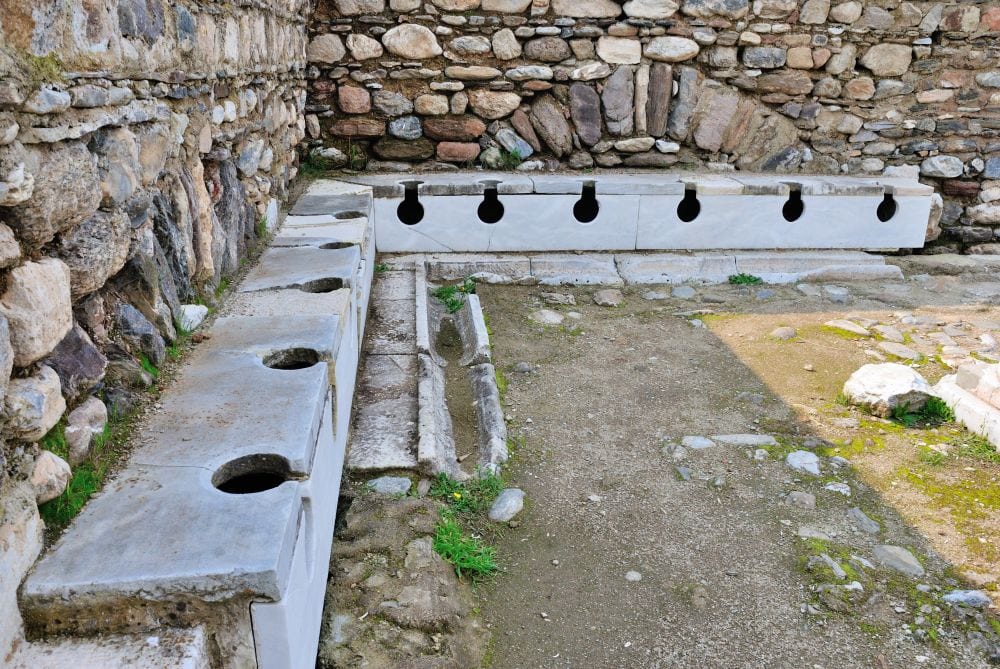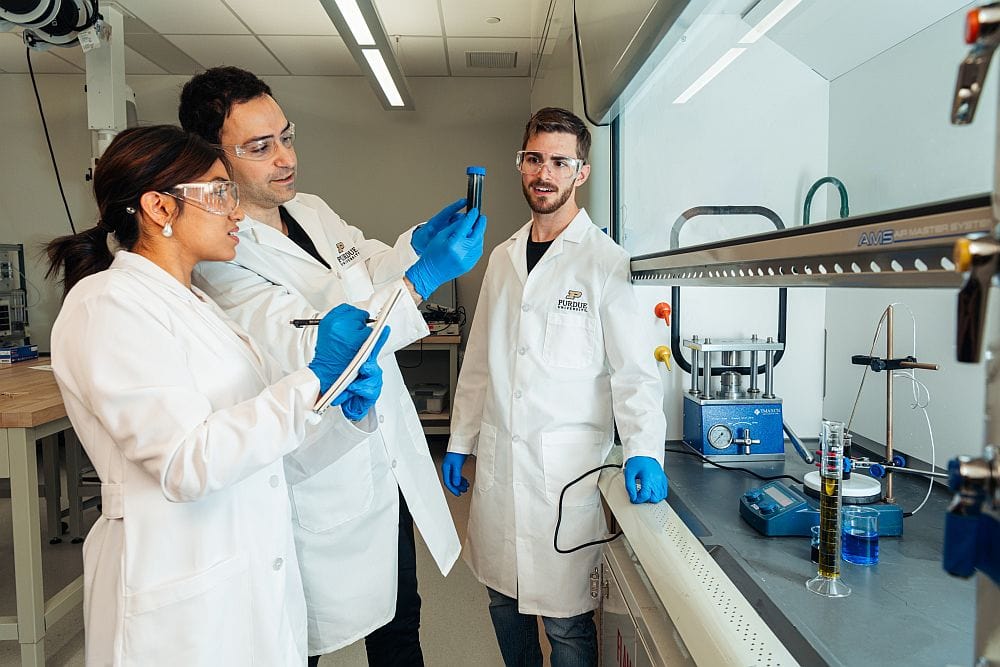
[Image above] Example of public toilets in the ancient city of Tralleis near modern day Aydın, Türkiye. Founded in the 13th century BCE, this important archaeological site has played a significant role in various civilizations, including the Hellenistic, Roman, and Byzantine periods. Credit: Nina Alizada, Shutterstock
Modern humans rarely give the convenience of indoor sanitary facilities a second thought, unless a situation arises that requires the use of a plunger. But most of us are not that far removed from the days of outhouses and chamber pots. My mother’s childhood home did not have an indoor bathroom until a year and a half after they moved in.
Even today, almost half a million U.S. households lack indoor plumbing. Globally, almost 60% of the world’s population lacks access to basic sanitation. For example, in rural Mongolia where I spent three weeks in 2019, approximately half of the population has access to facilities that safely manage waste. Pit toilets are a challenge for anyone who’s inclined to be clumsy!
So how did we get from pit toilets in some corners of the world to five-figure toilets that cost more than some cars in others? This CTT will explore the historical progression of toilet technology, touching on engineering and public health and highlighting the pivotal role of ceramic materials in the development of the modern, hygienic fixture most of us use several times daily.
Before the flush
The Harappan civilization developed indoor toilets attached to drainage systems by the mid-third millennium BCE. These toilets could be emptied by dumping a bucket of water into the pipes. Meanwhile, the city of Uruk in Mesopotamia (today’s Iraq) hosted internal pit toilets dating to 3200 BCE. This type of toilet required regular manual emptying, though, which makes this development not as practical as it might at first have seemed.
The ancient Egyptians used cesspool toilets with wooden or stone seats by approximately 3000 BCE, which were sometimes emptied onto the fields to act as fertilizer for crops. Around the same time, internal pit toilets connected to a drainage system appeared at Skara Brae in what is now Scotland. By 900 BCE, the latrines in ancient Rome had stone seats and were another example of that civilization’s ingenuity and efficiency, complete with running water from the communal baths to carry away waste and sponges on sticks to aid in cleanup.
As cities grew, so too did the necessity of sewer and drainage systems to manage human waste. Without proper sanitation practices, parasites carrying diseases could spread quickly and over thousands of kilometers, as excavations at an ancient latrine along the Silk Road in western China shows.
However, population declines in the Middle Ages slowed the spread of sanitation, as briefly explained in an earlier CTT about faucets. Many cities saw widespread use of wooden outhouses and chamber pots, which did nothing to effectively manage waste and sanitation.
When populations began to increase rapidly during the Industrial Revolution of the 18th and 19th centuries, widespread cases of cholera, tuberculosis, and typhus became the norm. The cholera epidemic that struck England in the early 1800s had a 50% fatality rate.
Flush with innovation: The modern toilet emerges
The first flush toilet was invented by Queen Elizabeth I’s godson, Sir John Harrington, in 1596. It consisted of a brick, stone, or lead receptacle waterproofed with pitch and wax. His oversized invention required 7.5 gallons of water from an upstairs cistern per flush, but up to 20 people could use it between flushes if necessary.
However, the flush toilet did not catch on until the late 18th and early 19th centuries, when population exploded as a result of the Industrial Revolution and inadequate sanitation became an urgent public health problem. Fortunately, this revolution also witnessed manufacturing and material innovations that made mass production of flush toilets and practical waste disposal possible.
For example, the S-shaped pipe under the toilet invented by Alexander Cummings in 1775 prevented the escape of sewer gases, which made indoor toilets more acceptable. Also, early toilet materials (e.g., wood, lead, porous earthenware, brick, stone) presented significant challenges for those charged with keeping them clean. Ceramics such as porcelain are much easier to clean, and the Industrial Revolution put the necessary infrastructure in place to allow their rapid adoption.
Mass production of iron, copper, and lead pipes, as well as terracotta sewer conduits, were another supporting pillar for improved sanitation. Widespread availability of running water in homes further increased adoption of flush toilets.
Many early flush toilet designs had the water tank mounted high up on the wall above the toilet bowl. By the 1910s, toilets with the tank mounted on the bowl came into use, and by the 1930s, most new homes and apartments were being built with dedicated bathrooms that do not look too different from those you find today.
Vitreous china and functional coatings ascend the throne
The adoption of vitreous china for toilet manufacture in 1885 by the English pottery manufacturer, Thomas Twyford, represented a huge leap for public health and sanitation. The man who bought Twyford’s patent, however, achieved a kind of immortality by becoming synonymous with this invention—Thomas Crapper, an English plumbing supplier.
Vitreous china is similar to porcelain, another popular toilet material. Both contain kaolin clay as a major component, but vitreous china also contains feldspar and quartz. During a two-step firing process, the components in vitreous china melt and fuse to form a glassy coating on the ceramic base.
The nonporous, glassy coating on vitreous china helps prevent bacterial adherence and growth while remaining durable and aesthetically pleasing. Furthermore, vitreous china is fired at slightly lower temperatures than porcelain and is typically less dense, which makes it less expensive to produce and easier to install.
Functional coatings and glazes are also common additions to vitreous china and porcelain toilets. Modern manufacturers use proprietary blends that claim to improve the stain resistance and ease of cleaning of their products, among other functionalities, by incorporating silver, titanium dioxide, and other materials.
Today’s toilet: A testament to material innovation
So, what makes some modern toilets worth upwards of $10,000? These luxury toilets feature built-in amenities such as seat temperature, personalized dryer functions, and music, but even then, the price is hard to justify for many consumers. Fortunately, I can tell you that modern bidet attachments are easy to install and often do not require electricity, if you want to upgrade your toilet on a budget.
Besides these luxury amenities, practical functionalities such as low-flush and dual-flush toilets, which are designed to use less water, are becoming more common in a world with increasingly scarce clean water supplies. Aftermarket adapters are available to add this functionality to your toilet as well.
Also, toilets with an integrated sink above the tank are a common feature in Japan. This design helps save water by reusing the water from handwashing for flushing. Retrofitting toilets with these sinks is catching on in other parts of the world, too.
Ultimately, no one needs a $10,000 toilet, but basic sanitation is a human right. With so many options for affordable plumbing thanks to hundreds of years of technological and material developments, organizations such as the Gates Foundation, with their Reinvent the Toilet Challenge, and the Toilets for People Foundation, which builds composting toilets with locally available materials, are helping to address the disparities in toilet access around the world.
Further reading
If you are interested in how toilets are fabricated, this video is interesting and short. The syllabus for a university course on The Secret History of Toilets is another fascinating source of background material, as well as the book The Archaeology of Sanitation in Roman Italy by Ann Olga Koloski-Ostrow. And now, you’re flush with knowledge!
Author
Becky Stewart
CTT Categories
- Education


